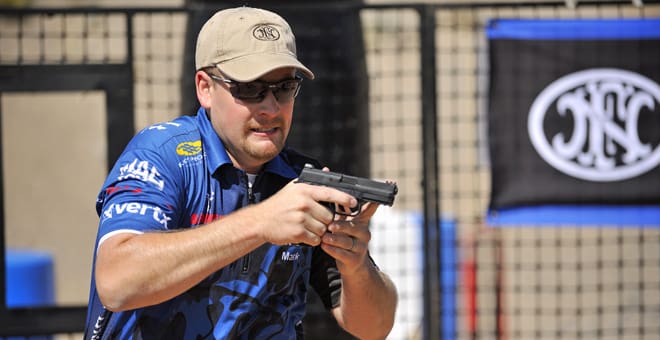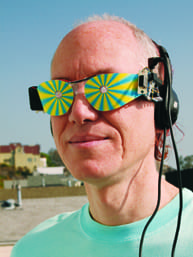I had just picked Robert up from Bush Intercontinental in Houston in advance of the NRA annual meeting, and was listening to his latest musings about life and firearms as I dodged through rush hour traffic to get to the other Houston airport on the opposite side of town where Dan was conveniently arriving. Robert had been a hypnotist in a previous life and after watching some of the videos of the FNH USA pro shooting team in action, he had a question: “How do these guys prepare themselves, mentally? What do they do? Do they have any rituals?” It was a damned good question, and I didn’t have an answer. So the next time I was with the team, I made sure to find out . . .
3-gun competitions aren’t just about firearms proficiency; they require critical thinking and decision-making skills as well. There’s a definite mental aspect to the game that becomes increasingly important the higher up on the results list you get. When one second is the difference between tenth and fifteenth place, being able to make a plan for each stage and execute it perfectly is an essential ability.
At the pro series competition in Tulsa (about two weeks after my conversation with Robert) I had my first chance to watch the team and see how each person mentally prepared themselves. And while there are some major differences in philosophy and ritual, the stage walk-through process is identical for each person.
For national level competitions, the team arrives the day before the shoot begins to register and check out the stages. In the fading light of another hot and humid Oklahoma summer day we went stage by stage, scoping each one out and planning our attack.
The first thing that always happens is that the shooter gets an overall impression of the stage, walking the entire shooting area and going behind the obstacles to get an idea of where all of the targets are laid out. Paper copies of the stage designs are sent out days in advance of the event, but what’s on paper almost never makes it onto the ground as intended. There are always gaps that weren’t planned, targets that have changed position and shooting positions available that weren’t obvious on the 3D rendering. The only way to find them is to visually inspect the stage and root them out for yourself.
Once you have an idea of what the stage looks like, you can start formulating your strategy. The first plan is almost never the right one, and by discussing it with the other guys on the team (and the other competitors scoping out the stages) you refine it to the point where you can’t see any more ways of shaving time off the stage. It’s an iterative process, one that’s helped by the next step in mentally preparing yourself.
After you’ve settled on a plan (or even just a draft), you run the stage. It doesn’t need to be at full speed, but beginning at the actual start position, you go though every motion you plan on making. You feel how your feet navigate the shooting area, how stable each firing location is and how long it’s going to take to get from one spot to the next. You hold your hands as if you were holding your gun, imagining yourself looking down the sights at each target. Each person has their own unique way of “air gunning” (think air guitar but with rifles and pistols), but every competitor does it. It gives them a way to test their theories before they’re on the clock, and sleep on it before they have to make the final decision and run the stage for real.
Up to this point, just about everyone prepares the same way. But from here, the theories begin to diverge.
After they step into the starting position on a stage, most competitors take a moment or two to think though their plan and quickly play it out in their head. Those competitors say that they do it to have their plan fresh in their memory, so they can almost run the course on auto-pilot with their body instinctively following along. Karla Herdzik takes that last minute mental walk-through to the extreme. As she’s about to start the stage, she closes her eyes and mentally runs the entire course one last time, complete with air-gunning and planned magazine changes. If you watch close enough, you can even see her silently counting the shots.
On the opposite end of the spectrum is Mark “SCAR-Javelin” Hanish. Mark’s probably the poster child for the laid back approach to running a stage, as he’ll scope it out beforehand and make a mental plan, but that’s about it. When his name comes up in rotation he walks to the line, makes ready and runs the stage doing whatever feels best at that moment.
That wasn’t always Mark’s approach.
We were sitting in a restaurant after the competition sucking down a couple beers and talking about the mental aspect to 3-gun when Mark let us in on something that he and a couple other shooters had experimented with earlier in his career. Apparently someone else had been as interested in the mental aspect of competition shooting as Robert was, and developed a method for the competitors to place themselves in a trance-like state before the stage. Mark described a device that sounds strangely similar to Mitch Altman’s Brain Machine that produced blinking lights and a monotone sound at a certain frequency that allowed him to shut off half of his brain at a time. The idea was to focus either on critical thinking or creativity as the situation required, even switching back and forth mid-stage as needed.
The hypnosis-based approach had fallen out of favor recently, but not for a lack of effectiveness. Mark spoke about the system with fondness, saying that it really did work and improved his score. But the idea of a hypnotized shooter might not be very appealing to those who don’t understand the concept, and so the project never really got off the ground.
Just about every other shooter can be described as some variation between those two polar opposites, either trying to get the stage design engraved in muscle memory or trusting your instincts to do the right thing at the right time. But as far as I can tell, the best shooters seem to take a middle-of-the-road approach, relying on a combination of both methods.
But no matter how well you prepare for the stage, when the buzzer goes off, it’s a whole different animal (from a mental perspective). But more on that soon . . . .
Want to start a different discussion or ask a question on another topic? Click here to go to TTAG’s Free Fire Zone.






If you haven’t already, I suggest you look into Lanny Bassham.
Wasn’t there a Sinatra movie (and horrible remake) about this?
Throughout my athletic career I have found visualization to be a powerful tool. I can imagine that using it for 3-gun competition would have the same effect. The mind is a powerful thing!
I play tournament golf and will be entering the PGA PGM program this year (to teach the game/run a golf course) and I will close my eyes before every shot and watch the flight in my head, then pre-shot routine, then hit the shot. Obviously not every shot goes as planned but it helps to keep one in the moment…
This is an easy one. I would just visualize the female competitors naked. I would be doing that anyway.
I shoot USPSA and the mental game was surprising at first. I’ll never forget how much my heart was pumping one my first ever stage. Having to make decisions, reloads, count shots, move and run, all while handling a loaded gun. I was nervous as hell and my score didn’t (and still doesn’t) matter. I had only owned a gun for a couple months at this point and maybe had a few hundred rounds down range. I do it for training and practice for concealed carry, because I don’t know any place I could shoot at similar set ups any where in my area. Either way, before I shoot a stage I do a walk through and count each round and know when I am going to reload. Its definitely gotten more about the game these days, but its still training for me. Shooting a bone stock glock 19 with 10 round mags (california). Nonetheless, my hearts always beating hard and I always have adrenaline pumping. I love it.
Comments are closed.